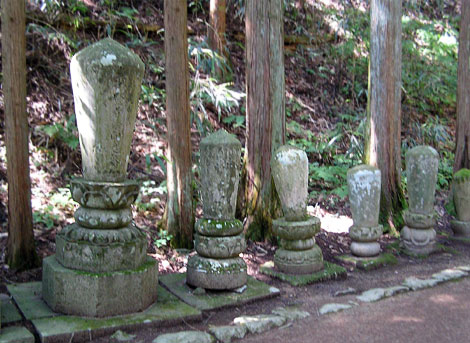|
||
 |
||

Jourakuji 常楽寺 (Nagano)
(C)2001 Japanese Architecture and Art Net Users System. No reproduction or republication without written permission.
掲載のテキスト・写真・イラストなど、全てのコンテンツの無断複製・転載を禁じます。
|
||||||
| muhoutou 無縫塔 | ||||||
| KEY WORD : architecture / buildings & structures | ||||||
| Also written 無方塔. Also *kaisantou 開山塔 or *rantou 卵塔 / 蘭塔 (egg-shaped pagoda). A type of pagoda marking the gravesite of a Buddhist priest. Originally used by the Zen sect, but later adopted by other sects. The muhoutou has a characteristic egg-shaped top, said to be a phallic symbol. There are two main forms of muhoutou: One type has an egg-shaped stupa body, toushin 塔身, resting directly on a ring of lotus petals *ukebana 請花. This is supported by a rather high octagonal base, with a lotus motif adorning each of the eight facets. The second type of muhoutou has a two-step hexagonal base; the upper step smaller than the lower one. These hexagonal steps are embellished with stylized lotus patterns carved in relief. A hexagonal shaft rises from the upper base stone, and this is in turn covered by a square cornice. On top of this is a double row of lotus petals supporting an egg-shaped symbol. Good examples of muhoutou include those at Sennyuuji 泉涌寺 (Kamakura period) in Kyoto and Jikouji 慈光寺 (1556) in Saitama prefecture. | ||||||
 Jourakuji 常楽寺 (Nagano) |
||||||
| REFERENCES: | ||||||
| EXTERNAL LINKS: | ||||||
| NOTES: | ||||||
(C)2001 Japanese Architecture and Art Net Users System. No reproduction or republication without written permission. 掲載のテキスト・写真・イラストなど、全てのコンテンツの無断複製・転載を禁じます。 |
||||||